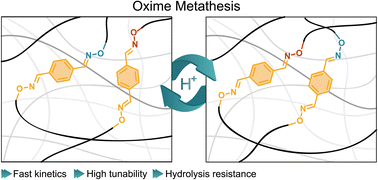Oxime metathesis: tuneable and versatile chemistry for dynamic networks†
Abstract
Oxime chemistry has emerged as a versatile tool for use in a wide range of applications. In particular, the combination of oximes with esters and urethanes has enabled the realisation of Covalent Adaptable Networks (CANs) with improved and tunable dynamic properties. Nevertheless, an exclusively oxime-based chemistry has not yet been explored in the fabrication of CANs. In this work, we investigate the mechanism of the acid-catalysed dynamic exchange of oximes. We propose a metathesis mechanism that is well supported by both experimental and computational studies, which highlight the importance of the substituent effect on the exchange reaction kinetics. Then, as a proof of concept, we incorporate oxime groups into a cross-linked polymeric material and demonstrate the ability of oxime-based polymers to be reprocessed under acid catalysis while maintaining their structural integrity.

- This article is part of the themed collection: 2024 Chemical Science Covers


 Please wait while we load your content...
Please wait while we load your content...